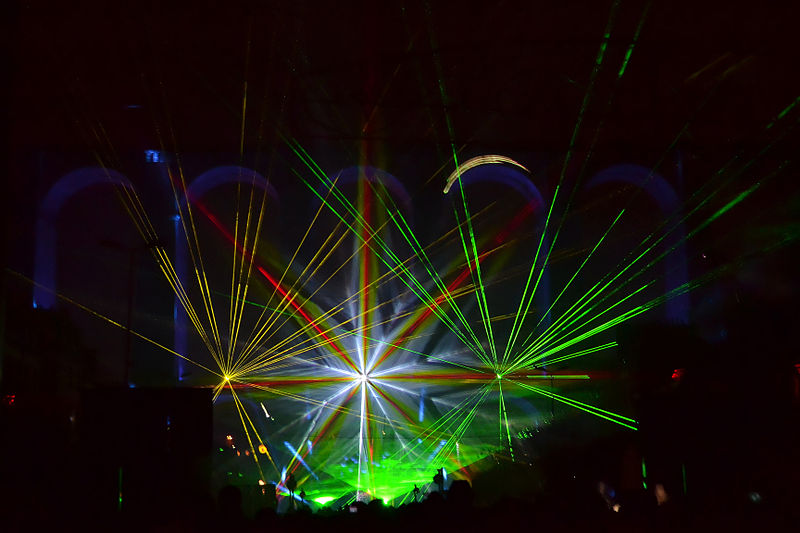By Geoff Giordano
With plenty of summer left to enjoy, it is appropriate to remind revelers to be aware when attending outdoor laser demonstrations or using handheld laser pointers. More and more handheld laser pointers are being sold to consumers and tourists — especially online — and they often exceed the output power listed on the label.
As lasers continue to break new ground as tools of healing, communication and entertainment, knowing how to avoid beam-related eye and skin injuries is paramount. New research illustrates the need for consumers to use caution and be aware of potential dangers.
A study presented at LIA’s International Laser Safety Conference in March warned of the dangers laser pointers present to youths. The study, led by U.K. ophthalmologist Fahd Quhill and related by ILSC General Chair John O’Hagan of Public Health England, presented cases of permanent eye damage suffered by five children in Sheffield, England. Consumer lasers given as gifts or acquired from websites, tourist destinations or modified commercial products cost some of those children more than 50 percent of their vision.
“What do you do” when a laser-related eye injury suffered by a youngster “wipes out the possibility of a whole range of career opportunities (for them)?” O’Hagan asked.
One move toward a solution came in February 2014 with a decision by the European Commission to put controls on laser products intended for consumers. According to O’Hagan, the decision indicates that “child-appealing products shall not cause damage to the eyes or skin in case of any exposure that could occur under any conditions of use, including deliberate, long-term exposure with optical viewing instruments.” The broadly applicable statement also helps regulate products intended for home hair removal. The decision allows the manufacture of products “that can do something to the skin providing (they) can’t harm the eye,” O’Hagan explained.
Meanwhile, increasingly popular laser light displays at concerts and festivals can pose a danger to spectators from unintended exposures to the laser source. Peter Blattner of the Swiss Federal Institute of Metrology (METAS) discussed the agency’s real-time assessment of laser shows and potential irradiation of spectators. The system was tested successfully in the field at about 20 laser shows in Switzerland, those tests often mandated by regulators or show operators. The tests found that all the shows exceeded maximum permissible exposure limits, Blattner said — some by up to 120 times those limits. The shows were adjusted to acceptable levels.
The challenge with laser light shows, said James Stewart of LVR Optical, is that “one minute they are quite smooth and fluid beams, the next minute they can (become) very stationary for a few milliseconds — enough time to create these accentuated, tight finger beams of light.”
Stewart and Blattner noted the prevalence of lower-cost laser projectors available to show organizers.
“As far as nightclubs go,” Stewart explained, “the entry-level (power) is three watts.” He notes that many people who attend his training sessions after recently purchasing a three-watt or five-watt laser for light shows “become a bit disillusioned” when they learn they can’t use the system to scan the crowd in their small venue.
In larger-scale uses, laser systems are typically eight to 30 watts, Stewart said, but typically only one to three watts would be used to scan an audience. He has been involved in assessing audience-scanning laser light shows presented by major global recording artists when they performed in the U.K. Even a one-watt laser will be hazardous at around 200 meters, he noted.
While show presenters can alter the laser beam to be less harmful to audiences, to avoid injury at shows, it is generally advisable not to intentionally stare or look at where the laser beam is coming from.
As O’Hagan pointed out, in some cases people struck in the eye by a beam from a handheld laser pointer were not injured by the beam but from rubbing their eyes after the fact.
To help inform the public, LIA created a primer on laser pointers and tips for using them safely. The guidelines are intended to be shared freely in the hopes of helping avoid accidents.
LIA advises the following in regard to laser pointers:
- Never shine a laser pointer at anyone. Laser pointers are designed to illustrate inanimate objects.
- Do not allow minors to use a pointer unsupervised. Laser pointers are not toys.
- Do not point a laser pointer at mirror-like surfaces. A reflected beam can act like a direct beam on the eye.
- Do not purchase a laser pointer if it does not have a caution or danger sticker on it identifying its class. Report suspicious devices to the FDA.
Geoff is LIA’s communications director. Contact him at ggiordano@lia.org to share your experiences with lasers, sound off on issues regarding any facet of laser technology, suggest stories or offer your commentary with a guest article or blog post.

